|
|
|
|
|
|
|
|
|
In This Issue
Santa Susana State Historic Park Adds Multi-use Trails The State of California began acquiring land for the Santa Susana State Historic Park in 1979. Located north of Chatsworth Park and south of Rocky Peak, the park has grown from subsequent land purchases to its present size of 670 acres. In 2007, CORBA representatives attended planning meetings, and provided input on the trails to the project manager. Thanks to this input, most of the trails in the general plan will be designated as multi-use trails. The trail of most concern was the Devil’s Slide area of the Old Santa Susana Stagecoach Road. This is a very steep and rocky section of trail. It is hard to imagine that stagecoaches traveled down this trail, but they did! This trail provides access to the park from the north side to the south side of the park and vice versa. If this trail had not been deemed multi-use, mountain bikers would have only had access from the southern trailhead at Valley Circle and Lassen Street. This would have made it impossible to loop the Park’s trails with the Rocky Peak area trails without significant paved road riding. Very few trails will be restricted to hikers only. Those that are, will be interpretive trails with informational signs describing the native people, plants and animals that inhabit or did inhabit the area in the past. The most controversial part of the plan for local residents pertains to a proposed campground. The locals are concerned about fires being accidentally started by careless campers, and about the potential that the campground would attract “undesirable types of people.” The proposed campground would be located on the old Spahn Ranch site. On Febuary 29th, 2008, CORBA and IMBA representatives were present when the State of California Recreation and Parks Commission approved the Preliminary General Plan!
NorCal High School
Mountain Bike League is Expanding to Southern California
IMPORTANT DATES 2008: October 25-26: SoCal Leader’s Summit (for adults interested in coaching) November 22: SoCal League CycleFest Benefit Dinner (Los Angeles) December 14-15: SoCal Riders Clinic #1 Registration For SoCal Teams And Riders Opens by January 1, 2009 For more information and/or to sign up for our newsletter, visit: www.socaldirt.org Hope to see you at a SoCal League event sometime soon! Matt Fritzinger, Executive Director (510) 653-2453, fritz@socaldirt.org CORBA Participates
in IMBA Summit After a warm welcome by our host, Kozo Shimano, at the Shimano headquarters in Irvine, the IMBA Southern California Summit focused on the issues that are critical to mountain bikers. The primary purpose of the June 7 summit was to coalesce the regional advocacy groups and share the common concerns that effect us all. Tom Ward, IMBA’s California representative in Sacramento, moderated and led the discussion with assistance from our local IMBA representative, Jim Hasenauer. CORBA was represented by board member Louisa Bonnie.
Other mountain bike advocacy groups in attendance included SHARE, Trails For All, Warrior Society, Central California Off-Road Cyclists, Go Bike, San Diego Mountain Bike Club, and Santa Barbara Mountain Bike Trail Volunteers. Representatives from Specialized, REI and Crank Brothers were seated at the conference next to Forest Service personnel, the Orange County Trails Commissioner, and State Parks Trail engineer Carl Knapp. Additional IMBA representatives attending were Daniel Greenstadt from San Diego and Rich Cook from Boulder, CO. CORBA is arranging a meeting of the advocacy groups in the Spring of 2009. For more information on the spring meeting, contact Louisa Bonnie: mtbike4@verizon.net. Local IMBA representative Jim Hasenauer can be contacted at: imbajim@ aol.com and IMBA California representative Tom Ward can be reached at: tom@imba.com.
What are the symptoms of heat exhaustion? Headaches are usually the first sign of dehydration. Light-headedness or dizziness are the last. Drinking plenty of water is critical. Other symptoms can include weakness, mood changes such as irritability, confusion, or the inability to think straight, upset stomach, vomiting, decreased or dark colored urine, fainting or passing out, and pale, clammy skin. What should you do if you or another has heat exhaustion? Act immediately. If not treated, heat exhaustion may advance to heat stroke or death. Move the victim to a cool, shaded area to rest. Don’t leave the person alone. If symptoms include dizziness or lightheadedness, lay the victim on his or her back and raise the legs six to eight inches. If symptoms include nausea or upset stomach, lay the victim on his or her side. Loosen and remove any heavy clothing. Have the person drink cool water (about a cup every 15 minutes) unless sick to the stomach. Cool the person’s body by fanning and spraying with a cool mist of water or applying a wet cloth to the person’s skin. Call 911 for emergency help if the person does not feel better in a few minutes. RIDER ETIQUETTE:
RULES OF THE TRAIL
Here’s what our esteemed Jim Hasenauer has to say: “Yield means SLOWDOWN, be prepared to stop, establish communication and then pass safely. So actually, both riders yield and should be prepared to stop, and then they work out the pass. It’s similar to cars merging on the freeway. The oncoming car has to find the safe space to move into, but a car already on the freeway is likely to move over and make room. There’s no set rule who must yield uphill or downhill, but it’s been generally accepted that the rider moving downhill yields, because it’s easier for them to get started again. No one should assume that another is going to stop, dismount, et cetera. It’s all about the communication.” Bottom line: When in doubt, yield the right-of-way.
As new residences in Dos Vientos division of Thousand Oaks sprang up several years ago, so too did a new open space, which was followed by new trails. There are now over 17 miles of multi-use trails, of which almost 60% is single-track. This includes the Reino Trail that connects to Newbury Park, and was constructed in large part by CORBA and IMBA. There are about two dozen access points and connections to neighboring Newbury Park, Rancho Sierra Vista/Satwiwa and Pt. Mugu State Park (aka Sycamore Canyon), and even Camarillo via Conejo Mountain Edison Road. With so much access, there are plenty of opportunities to try out these trails.
Housing construction continues, and when completed, more trails will be accessible, though some access points may change. The Conejo Open Space Conservation Agency manages Dos Vientos and many other recreational open spaces in Thousand Oaks. For more information go to www.cosf.org. Detailed trail descriptions and maps can be found at: www.venturacountytrails.org/TrailMaps/DosVientos/AreaTrails.htm CLUB SPOTLIGHT: Over the Bars Mountain Bike Club (OTB) OTB began in 1993. Regular weeknight rides are at 6:00 pm every Tuesday and Thursday all year. The weeknight rides are usually open to all levels of riders. The club also rides on most Saturdays with occasional Sunday rides as well. The weekend rides are usually for intermediate – advanced riders. Locations vary and often include rides in the Verdugo Hills, San Gabriel Mountains, Santa Monica Mountains and the Santa Susanna Mountains. OTB has several MTB trips throughout the year. Past trips have included Mammoth Lakes, Santa Cruz, Arizona, and Utah. There is also an annual road bike tour each year. These road tours have included trips through California’s National Parks, along the California Coast, Baja California, and Cuba. OTB members are also very active participants on CORBA Trail Crew trail maintenance days. For more information visit www.otbmbc.com There are many ways to enjoy a trail. Most CORBA members list mountain biking as their favorite, though many also enjoy hiking or backpacking. For a true nature experience on a mountain bike, nothing comes close to bike-packing, which combines the mountain bike’s ability to cover more distance with the solitude and adventure of an overnight backpacking trip.
Pack Smart When bike-packing, weight is a big factor. It’s amazing how little we must have to survive in the outdoors: water, food and shelter. Water is one of the heaviest things to carry, but is our most vital human need. Think about water sources when planning your route, and the need for purifying water. For food, dehydrated camp foods and calorie-dense snack foods give the best calorie to weight ratio. Do you really need a tent, or can you get by with a bevy sack or just a sleeping bag? Multi-purpose items save weight as well; a rain-poncho that doubles as a tent, or the pot in which you cook can double as your serving bowl. When packing, keep asking yourself, “Do I really need this? Is there a lighter option that will get the job done? Will wearing the same shorts two days really hurt me?” Think light, not luxury.
Spending two nights at the same camp, and doing a day-ride from the campsite without your overnight gear is a great way to put together an easy three-day trip. With the rising cost of fuel, camping fees, and concern for the environment, bike-packing is a rewarding way to spend a few days communing with nature, on a mountain bike. Glendale Trail
Master Plan Update As reported in past issues of the Terra Times, the City of Glendale was very receptive to receiving input from CORBA for their Master Trails Plan. In fact, CORBA volunteers did much of the work that ended up in the plan, which was approved by the Glendale City Council this past January. We were very happy with the result. The Master Plan includes trail corridors that we suggested would enhance the existing fire road network with a number of new single track trails in key areas. It also includes a provision for a Mountain Bike Skills Park in the San Rafael Hills. We recently completed our first ever trail work days on Glendale City lands. In June, our first project was on the short single track trail at the bottom of Las Flores Motorway, which is located above Sunshine Drive. In July, CORBA also conducted an introduction to trail maintenance class and field session for Glendale City volunteers at Deukmejian Wilderness Park on the Rim of the Valley Trail. We’re excited to continue working with the City to start implementing their new Trails Master Plan sooner, rather than later. The Bike Park is a big draw, and has the potential to be an incredible resource to the greater Los Angeles area; especially for the youth and residents of Glendale. Three sites are under consideration. The first site will most likely be used for expansion of the soccer fields. We’re waiting on final word on the second site, known as “Site C”. There is also a third site with good potential as well. Once a site is identified and the proper studies are complete, we can begin surveying the site and making recommendations. CORBA expects to continue to play a significant role and keep this process moving forward, and to support Glendale in their efforts. The City of Glendale has already expressed their gratitude for our support, and have proven to be very accommodating to the needs of mountain bikers. Trail-Maintenance:
Why Do It? Since becoming the CORBA Trail Crew leader three years ago, I have heard many different opinions pertaining to “optimal” trail conditions. Some riders tell me they prefer the trails as smooth as the bike path at the beach. Highly skilled riders are seeking more technical trails. I have even heard from some riders that think we should leave the trails as they are and let nature take its course. One thing is certain; there is a need for all types of trails to accommodate the different skill levels of riders.
When we plan for a trail’s maintenance, one of the most important considerations is determining if the trail is sustainable. Water-induced erosion is a trail’s worst enemy. We need to consider what a trail could look like in several years if the current rate of erosion continues. Rain induced ruts can add technical challenges. However, if the trail eventually erodes or slides away, it is much harder to rebuild it then it would have been to prevent the erosion from happening in the first place. So we must add water diversions to the trails to prevent erosion. The best method of water diversion is the rolling grade dip. When done properly, you will not even notice it is there. It is also important to maintain an out slope to the trail tread so that water will sheet off the trail instead of running down its center.
Another important factor when maintaining trails is creating clear sightlines. The benefit is enhanced safety for everyone as riders and other trail users can clearly see the trail, obstacles, and other trail users ahead. Without periodic brushwork, vegetation will take back the trails. This past Spring proved to be a year of significant plant growth, as you may have noticed on local single-track trails. Please come out and help the CORBA Trail Crew maintain the trails that give you so much pleasure and good health. Our schedule is available on the CORBA web site under "Trail Activities." Contact and General Information
|
||||||||||||||||
Copyright 1987-2020 CORBA. All Rights Reserved.
Privacy Policy





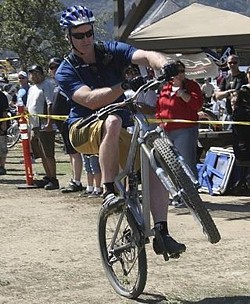 Join us in celebrating this fantastic sport while
supporting CORBA’s community- based programs and advocacy
efforts that keep the trails open for you to ride. Come
out for the fun, win bikes and other prizes, hone your
skills or learn new ones at the MTB pro clinic, enjoy
great food, and cross-country rides! Your contribution
and participation provides vital support for CORBA’s
goals.
Join us in celebrating this fantastic sport while
supporting CORBA’s community- based programs and advocacy
efforts that keep the trails open for you to ride. Come
out for the fun, win bikes and other prizes, hone your
skills or learn new ones at the MTB pro clinic, enjoy
great food, and cross-country rides! Your contribution
and participation provides vital support for CORBA’s
goals.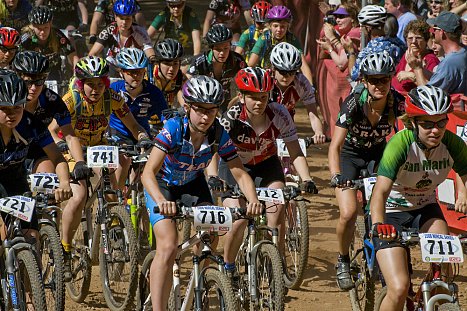 The
Northern California High School Mountain Bike Racing League (
The
Northern California High School Mountain Bike Racing League (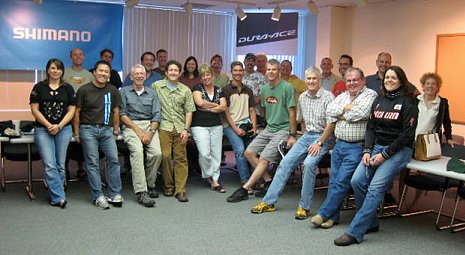 The
discussions included the Boxer wilderness bill and preserving critical
trails within targeted wilderness areas, gathering local knowledge
and information about these trails, State Parks development of consistent
procedures for changing trail designation, relations with the equestrian
community, creation of ride centers and bike parks, and the building
of illegal trails. The summit reinforced the importance of staying
connected, sharing information and improving communication between
the advocacy groups thereby strengthening our ability to reach our
goals.
The
discussions included the Boxer wilderness bill and preserving critical
trails within targeted wilderness areas, gathering local knowledge
and information about these trails, State Parks development of consistent
procedures for changing trail designation, relations with the equestrian
community, creation of ride centers and bike parks, and the building
of illegal trails. The summit reinforced the importance of staying
connected, sharing information and improving communication between
the advocacy groups thereby strengthening our ability to reach our
goals.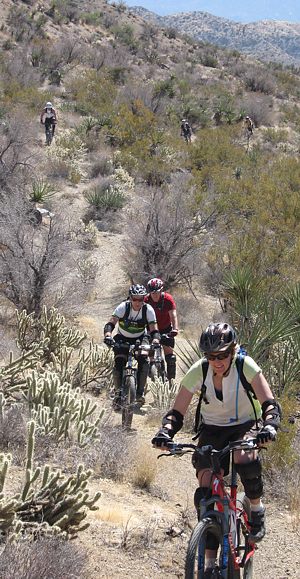 Summer is nearly over, but the hot months of September and October
are just around the corner and temperatures have already passed
100 degrees several times. Here are some tips to help you safely
enjoy riding in the summer and warm fall months.
Summer is nearly over, but the hot months of September and October
are just around the corner and temperatures have already passed
100 degrees several times. Here are some tips to help you safely
enjoy riding in the summer and warm fall months.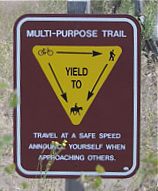 I
have been riding mountain bikes since 1983 and have been involved
in advocacy since 1987, so a lot of these rules of the trail are
second nature to me. As I started to write down my thoughts, I realized
that many things have changed since the CORBA Rules Of The Trail
were first penned (which just happen to be IMBA’s rules boiled down
to the bare essentials – mostly from input from our own Jim Hasenauer).
Following are the things that I tell people when asked if I have
any suggestions on proper backcountry etiquette while on a mountain
bike. These are not in any particular order of importance.
I
have been riding mountain bikes since 1983 and have been involved
in advocacy since 1987, so a lot of these rules of the trail are
second nature to me. As I started to write down my thoughts, I realized
that many things have changed since the CORBA Rules Of The Trail
were first penned (which just happen to be IMBA’s rules boiled down
to the bare essentials – mostly from input from our own Jim Hasenauer).
Following are the things that I tell people when asked if I have
any suggestions on proper backcountry etiquette while on a mountain
bike. These are not in any particular order of importance. 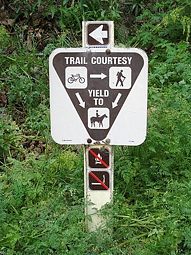 If you come upon a group of hikers that won’t move out of
your way, get off your bike and walk into the group, asking
nicely if you can “play through". Hikers seem to get the
golf reference.
If you come upon a group of hikers that won’t move out of
your way, get off your bike and walk into the group, asking
nicely if you can “play through". Hikers seem to get the
golf reference.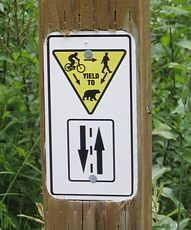 We’re all familiar with the “yield protocol,” right? Hikers yield
to equestrians, cyclists yield to hikers and equestrians. However,
there is no rule pertaining to who yields to whom when you’re on
a bike and encounter someone going uphill or downhill. I’ve stopped
for riders in each direction, depending on who it was easier and/or
safer for to stop. If you can pass each other safely without stopping,
go for it. But remember, when you’re on a singletrack, look at the
trail, not the rider, or you’re likely to run into the rider. Also
you should always stay to your right when passing other users coming
towards you.
We’re all familiar with the “yield protocol,” right? Hikers yield
to equestrians, cyclists yield to hikers and equestrians. However,
there is no rule pertaining to who yields to whom when you’re on
a bike and encounter someone going uphill or downhill. I’ve stopped
for riders in each direction, depending on who it was easier and/or
safer for to stop. If you can pass each other safely without stopping,
go for it. But remember, when you’re on a singletrack, look at the
trail, not the rider, or you’re likely to run into the rider. Also
you should always stay to your right when passing other users coming
towards you.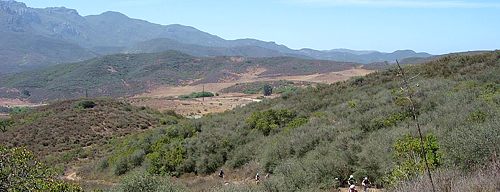
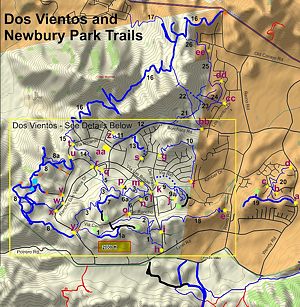 The singletrack is built to modern multiuse standards. Typically
the trail will climb a ridge from street level, follow a contour
for some distance with a great view into the valley below, and then
descend back to the street.
The singletrack is built to modern multiuse standards. Typically
the trail will climb a ridge from street level, follow a contour
for some distance with a great view into the valley below, and then
descend back to the street.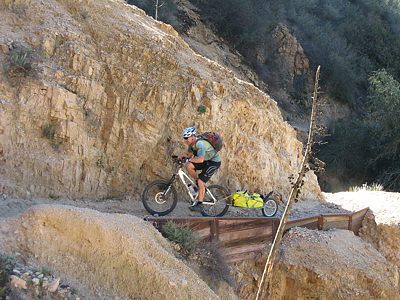 There are a number of ways to carry overnight gear on a mountain
bike. Bob trailers work really well, but can be heavy for long climbs.
Backpacks work too, but make bike-handing on technical trails more
difficult. A combination of a small backpack and frame packs or
racks and panniers also works well, and probably allow for the most
efficient travel.
There are a number of ways to carry overnight gear on a mountain
bike. Bob trailers work really well, but can be heavy for long climbs.
Backpacks work too, but make bike-handing on technical trails more
difficult. A combination of a small backpack and frame packs or
racks and panniers also works well, and probably allow for the most
efficient travel.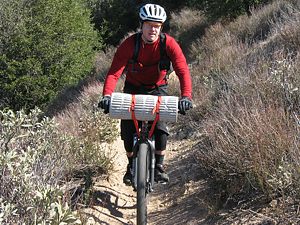
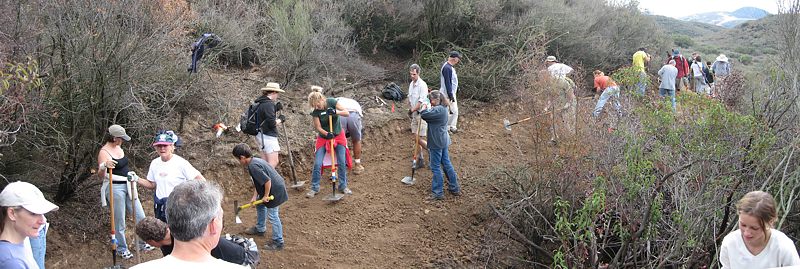
 There are better ways to add challenges to trails then letting
them erode. Leaving or adding rocks and logs on the trail can add
challenges far better than erosion ruts. They will also slow riders
down. Riders will be traveling at slower speeds yet have the sensation
of speed due to more technical challenges. And the trail will be
both sustainable and easier to maintain.
There are better ways to add challenges to trails then letting
them erode. Leaving or adding rocks and logs on the trail can add
challenges far better than erosion ruts. They will also slow riders
down. Riders will be traveling at slower speeds yet have the sensation
of speed due to more technical challenges. And the trail will be
both sustainable and easier to maintain.
